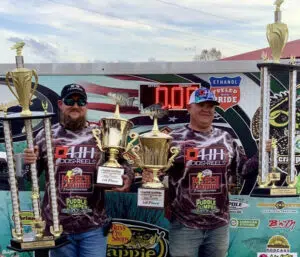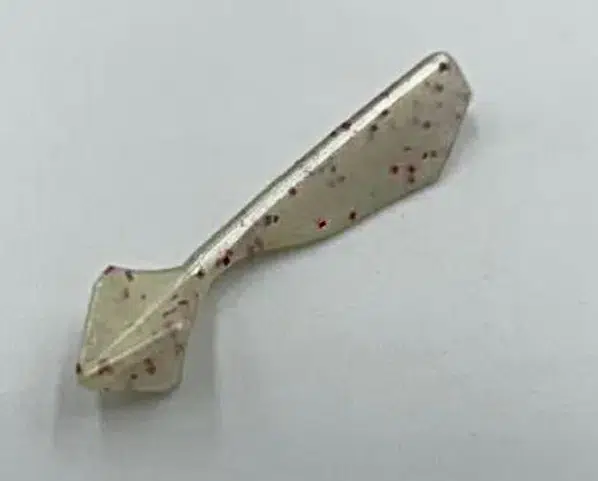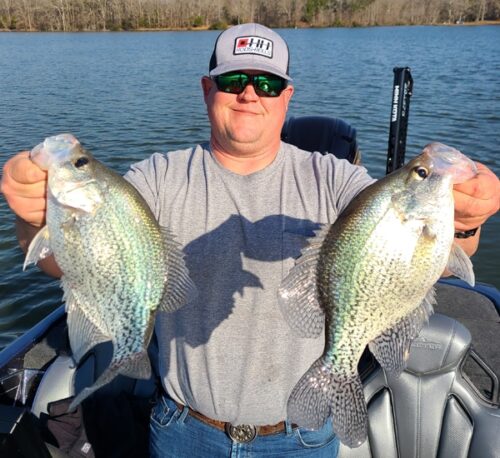PLEASE SHARE
WE ARE YOUR SOURCE FOR FISHING DESTINATIONS IN ALABAMA!
Summer Crappie on the Alabama River

Winning tournament angler and guide Brandon Threadgill has solved the mysteries of finding and catching crappie on the river in summer.
By Eileen Davis
Flowing from the confluence of the Coosa and Tallapoosa rivers near Montgomery, the magnificent Alabama meanders southwesterly for 304 miles before meeting the lower Tombigbee to form the Mobile River. Along the way, it fills three reservoirs and offers some of the state’s best crappie fishing.
Whether fishing Jones Bluff, Millers Ferry, or Claiborne, these lakes have the potential to produce heavy stringers of slabs in summer. Unlike many of Alabama’s reservoirs, much of these lakes remain within their original river banks.
Winning tournament angler and guide Brandon Threadgill of Valley Grande has solved the mysteries of finding and catching crappie on the river. “One day the river will have current,” Threadgill said, “and the next day not. If you do not know where to find the fish when conditions change, it can be frustrating. However, with experience, summer patterns are predictable on the river.”
Early Summer Pattern
In early summer, Threadgill targets post-spawn crappie using creeks to migrate from their spawning areas to the river. Depending on when spring melds into summer, he says anglers will find the fish in the first 200 yards of the creeks. Threadgill only fishes creeks with a deep channel.
“Crappie want access to deeper water,” Threadgill said, “and they need a sufficient level of dissolved oxygen during summer. Oxygen levels are too low in the cuts off the river.”
To ensure success, Threadgill, like all guides and most tournament anglers, creates artificial habitat for crappie. He sinks approximately 100 oak stake beds every year on flats at least 12 feet deep next to creek channels.
When Threadgill enters a creek, he searches the stake beds for crappie using side scan sonar set to a range of 100 feet. To keep from spooking fish, Threadgill marks those stake beds with buoys.
Without knowledge of Threadgill’s crappie motels, use your sonar to find stumps, snags and fallen trees on the flats. If you find a big oak that has fallen over, and the branches are still intact, it’s perfect cover for holding fish. These trees create shade, form a current break and provide protection from predators.
After marking three fish-holding stake beds with buoys, Threadgill returns to fish the first one.
Threadgill continued, “I start fishing by casting over the stake bed. I catch as many as I can before moving closer and using a long rod to dip my jigs into the cover. Usually, I catch the biggest fish with the long rod.”
Threadgill’s go-to lures for casting and jigging are a Bayou Bob’s hand-tied, gray/sliver hair jig and a Puddle Jumper Gator Shad, which he designed. For the soft plastic, his favorite colors are milky blue ice and pink glitter. These are Threadgill’s primary lures for fishing his summer river patterns.

For casting the 1/16 and 1/8 lure weights he prefers, the guide uses a 6-foot C & M Eric Cagle Signature Series rod with a 1000 Pro Series Spinning Reel. For fishing vertically, Threadgill’s long rod is a 13 1/2 foot Warpig Frank Haidusek F&M Signature Series with a Hurricane KF150 Spinning Reel.All of his gear is by HH Rods and Reels.
When asked about presentation, Threadgill said lure profile is more important than color, with speed being a close second. “At times,” he said, “crappie want a bait to sit still before biting. Other times, it takes a fast moving bait to trigger a reaction bite.”
Summer Pattern
Fishing the flats off creek channels ends when water temperature reaches 80 degrees.
“After the water warms,” Threadgill said, “I fish creek mouths and the inside bends of the river. Creek mouths are especially good when there is strong current or the water is muddy. Instead of relating to cover, crappie will hold in the open water waiting for bait fish to be delivered by the current.
“When fishing on the river, I look for laydowns in 10 to 15 feet of water on inside bends, which tend to have less current. It is not necessary for the area to hold bait fish, because the crappie know at some point the current will provide.

“I only use the long rod when fishing laydowns, and I use the same lures as before. Start by trying to catch the fish at the top of the pile and then work a little lower. I do that so I don’t catch fish below those higher in the water column and spook them. This is especially important with black crappie, as they will flush like a covey of quail”
Threadgill uses the spot lock on his trolling motor to hold his boat position in the current. He recommends anglers may want to invest in lithium batteries if they plan to fish tree tops on the river.
Additionally, Threadgill says anglers with forward facing live sonar will need to have their transducers mounted on a separate pole. For more information on fish behavior Threadgill has observed using Garmin LiveScope click here.
To book a fishing trip on Jones Bluff or Millers Ferry with Brandon Threadgill visit his Facebook page.
Read more about how successful anglers find and catch Bama’s fish.
